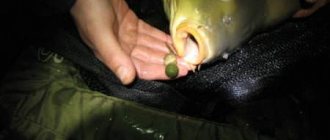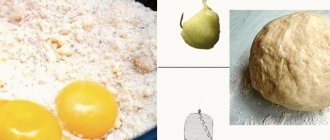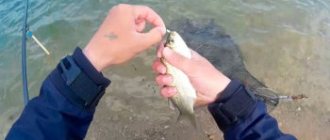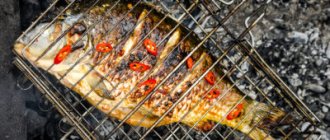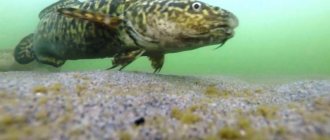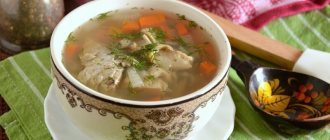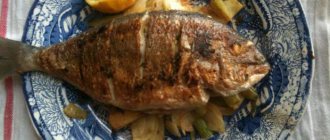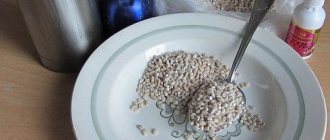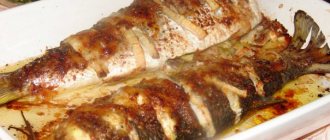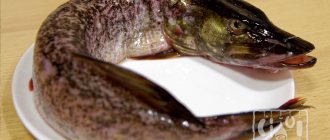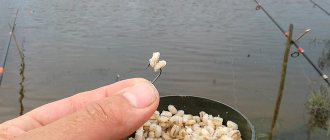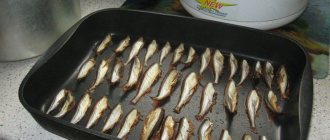Recipes for popular plant baits - ten of the best recipes for preparing baits for catching almost any peaceful fish.
When catching bream, crucian carp, carp and carp, peas can provide excellent assistance. There is an opinion among some fishermen that this is purely “bream food”, but this is far from the case. Try using it when fishing for carp and you will be rewarded. In addition, its low cost and ease of preparation can create a good alternative to ready-made bait.
And the simultaneous use of peas as a bait and in groundbait will give even greater results. Properly cooking peas for use in the feeder and on the hook is not so easy.
We have selected two videos as an example of how you can use peas as a base in bait and as a bait on a hook or hair.
Many people know that adding large fractions to a bulk mixture better attracts and retains large fish. You can, of course, add corn and pearl barley as large fractions, but peas are just as suitable for this role, and often work better.
- How to cook unshelled peas?
- How to cook split peas?
- How to properly place peas on a hook?
But bodies of water are different, you need to experiment everywhere. The “corn mania” imposed on pages and screens may be to blame for the catchiness of corn. In any case, every fisherman who goes fishing for large carp fish should take boiled peas with him.
Peas as bait for fish are very similar to corn - high attractiveness and cutting off small things. Moreover, with regard to small things, peas act quite radically. Catching a pea-sized fish weighing less than 0.25 kg is rare. At the same time, for large specimens this pea retains its extraordinary attractiveness. The fish is always ready to gut a pea, as long as there is a physical opportunity for this.
Peas or corn
Which is more attractive - peas or corn? First of all, both nozzles still need to be prepared. With corn it is much simpler - it is sold in a ready-made form that is attractive to fish, canned, which means boiled with added sugar, or even has elements of fermentation.
For canned green peas, the situation is completely different. It is rarely caught. Only old boiled peas are particularly attractive to fish.
If we take into account the frequently heard opinions of fishermen and analyze their catches, it can be noted that corn works better for large carp. And peas for bream.
But bodies of water are different, you need to experiment everywhere. The “corn mania” imposed on pages and screens may be to blame for the catchiness of corn. In any case, every fisherman who goes fishing for large carp fish should take boiled peas with him.
How to cook peas for fish
You need to buy peas first. For some reason, only pea chaff is found in supermarkets. You need to look for whole peas in markets, among animal feed. If you come across several varieties, then you need to take the hardest and largest.
Before cooking, peas must be soaked for 5 to 8 hours. In summer there is no need to overcook, otherwise it may ferment. The fermented one can be used for large carp. In cool conditions, it is better to extend the soaking to 12–18 hours so that the grains soften. It is advisable to take water from a spring or reservoir, i.e. without bleach.
It is useful to add salt and sugar to the water during cooking.
How to properly place a pea on a hook
It is advisable to plant the pea in such a way that the sting comes out. Then there will be no problems with the serif. If the sting is left under the skin, based on the rule - “the fish should not prick itself on the hook,” then the result will most likely be bad. Even when done, rarely leads to results?
Tips for fisherman: How to make tackle for catching bream - What is the difference, pros and cons
You can also put several peas on the hook, which is more useful when catching large specimens of bream and carp. But with hooks made of thick wire (carp) there may be problems, since carp hooks can crush peas. You can use this hook to pry the skin of a pea from the side of the sprout. You just need to discover it.
For example, to catch carp, corn is placed on a hook as follows.
How to make groundbait with peas
It’s also a good idea to use steamed peas as large components of bait, since this product is cheap, and you need a lot of food for large summer fish. In the bait version, peas can be slightly overcooked, i.e. There are no such requirements for peel cracking. There are several options for presenting it:
Mastyrka – pea attachment
Boiled peas can be added to any dough-like attachments and get the so-called mastyrka.
Classic mastyrka is prepared as follows:
The result should be quite viscous, but very soft, with a magnificent mountain smell - an excellent bait for catching small carp fish.
Using the mastyrka principle, you can prepare bait balls based on peas, or viscous bait for bottom gear. Only then are a variety of fillers added to the boiling pea mass, including grains - boiled hemp, ground seeds, pearl barley, ground gingerbread, wheat flour, oils, etc.
After cooking, drain off excess water and cool the peas. Whole seeds suitable for bait are washed with water and laid on paper to dry.
Content
- 1 Peas for fishing 1.1 Choosing peas for fishing
- 2.1 Methods for preparing peas 2.1.1 Peas for fishing in a slow cooker
- 3.1 Feeding with peas
How to put peas on a hook
How to put peas on a hook
Tips for a fisherman: How to cook millet for bream fishing - Answers for beginners
How to put peas on a thicker hook (the so-called carp hook)? Due to inexperience, the pea is easy to break. Hint: prick the hook near the sprout, which is easy to spot on each pea. Next, about the sting - if you don’t bring it out, then it is strictly necessary to hook, otherwise even “locomotive” bites will have zero results. However, a float rod or half-bottom requires a very energetic hooking.
Any fish with sufficient pharyngeal teeth will readily eat peas. Accordingly, it is unlikely that a fish smaller than 300 g (something like a bream, roach, etc.) will bite on a pea bait - if one is caught, it is extremely rare. Peas are equally good not only when using bottom, but also any float fishing tackle. Focus on the specific situation, look at the conditions of your fishing.
Fishing baits are some of the best. TOP 7. The importance of bait when fishing is difficult to overestimate, especially for feeder fishing. A hit parade of fishing baits, born from hours of practice on the pond! For carp, for bream, for roach.
Peas for fishing
Peas
Along with corn, peas are often used for fishing - they are used to catch fish on rivers and lakes. Moreover, in any of its forms - fresh, canned, boiled - it is distinguished by its original taste, which attracts fish. Peas were loved by ide and bream, crucian carp and carp, roach and silver bream, and carp.
And if the fish like this bait only for its taste, fishermen also prefer it because of its objective practical advantages:
- Properly prepared (or selected), peas hold well on the hook, even if you have been fishing with them for quite a long time.
- This attachment can be mixed with some other attachment (for example, boiled with wheat flour) and an even more interesting multi-component attachment can be prepared.
- It is not a problem to buy peas in any form: for example, canned in jars, they are available in almost every grocery store.
- The green color is a camouflage color and does not alarm the fish - they bite on it.
It is clear why fishermen who know how to prepare this bait value it so much. But peas can also be groundbait, or rather, a component of it.
Choosing peas for fishing
Peas for fishing
can be whole or shelled (halves). Split peas can be used to prepare groundbait and also be used in feeder gear. It is especially effective to catch bream this way. In addition, you can make mastyrka from split peas.
Whole peas are traditionally used as bait.
In addition, you can use fresh green peas - they do not require cooking, as well as canned green peas. In addition, frozen peas are available for sale. It is also quite effective. It is also convenient because there is no need for pre-soaking and long cooking. You only need to cook it for a few minutes.
The next thing I would like to pay attention to is the appearance of the grains. Experienced fishermen claim that wrinkled varieties are more suitable for fishing than smooth ones.
Using peas for fishing
From the many years of experience of his predecessors, the modern fisherman already knows that bait like peas is practical in both standing and flowing waters. The persistent aroma actively attracts the inhabitants of rivers and lakes to feast on such a find.
Feeding the area where the fish hunt will take place plays an important role. The prey must be familiar with the smell of the bait, otherwise there is a risk of unsatisfactory bites.
At first glance, everything is quite simple, but you need to be able to choose and prepare this valuable plant product correctly.
Preparing peas for fishing
So, how to cook peas for fishing?
The cooking process itself is simple, but you need to follow a few rules. The quality of bites largely depends on how well the bait on the hook is prepared.
Peas have a whole, intact shell and a soft (but not crumbly) consistency. To check the quality of the bait, squeeze the seed - it should change shape slightly, but not be crushed. But if the peas are already overcooked, then there is no need to be upset, mash them and prepare mastyrka. This, of course, is a different bait, but also quite attractive to fish.
Methods for cooking peas
- The first way to boil peas for fishing
. So, not everyone knows how to cook peas for fishing. But if you plan to catch carp or carp, then you will have to master these skills. The easiest way to prepare this bait is as follows. We carefully sort the peas and leave only whole, undamaged seeds. Rinse them well in a colander under cold running water for several minutes. After this, pour the peas into a saucepan and fill with warm, but not hot, water. Leave to soak for at least 6 hours. It's best to let it sit all night. Many people soak it for a whole day, which makes it easier to prepare later. After the allotted time, wash the peas again and set them to cook. Make the fire small, so that the product does not boil, but rather simmers. We check its readiness every 5 minutes. Cooking time will depend on how long it was soaked and what type of peas it is. The shell of the finished pea will be intact, and when you press on it, it will shrink, but not fall apart.
- The second method of preparing pea bait
. Pour the already sorted, washed and soaked whole seeds into a small saucepan. Add water and bring to a boil over high heat. As soon as the water boils, immediately remove it from the burner and let it cool slightly. After that, take a large saucepan and pour water into it, place our small saucepan on top and put everything on the stove. Gets something similar to a water bath. Approximate cooking time – 2 hours.
- The third way to boil peas for fishing
Cooking peas for fishing in this case can be called gentle. The seeds themselves do not jump in boiling water, so they are practically not injured. For cooking, take washed and well-soaked peas. We pour it into a pre-prepared cotton bag. We tie it and tie it to the handles of the pan, into which water was previously poured. The bag of peas should not touch the bottom. Cook this way over medium heat. Periodically we untie the bag and check the peas for readiness.
Peas for fishing in a slow cooker
It is not necessary to cook soaked peas on the stove; you can also use a slow cooker. It’s easier and sometimes even faster. Take a bowl and pour peas into it. Add a couple of cloves of crushed garlic. This will enhance the effect. Carp and carp are very fond of this aroma, especially in autumn. Now we take a special colander from the multicooker for steaming and pour the peas into it. But the layer should not be very thick. Set it to “Steam” mode and set the time to 45 minutes. Then all that remains is to lay out the peas and cool.
Steaming peas for fishing
We take a thermos. Of course, any will do, but the ideal option is with a glass flask. Pour peas into it 1/3 of the container volume. Pour a spoonful of soda into it and fill it with boiling water so that the water is about 2/3 of the capacity of the thermos. Close tightly and leave for 6 hours. Naturally, the peas must first be washed and sorted well.
Rules for selection and features of the ingredient
Peas are round beans that contain a decent amount of fiber and protein. Most fish belonging to the Cyprinidae family readily consume the fruits of this plant in almost all forms of preparation: boiled, soaked, steamed, whole or crushed peas. It is possible to add them to bait; fishermen also use peas as bait.
It is advisable to hide the point of the hook; most species of the Cyprinidae family are careful and may refrain.
Serious selection of beans is required for hooking. It must not be allowed to jump off the tip or break. The main requirement is that the peas must be elastic and strong. Only whole peas are used as attachments. Undercooked, soaked or canned beans – “green peas” – are suitable. The requirements for the latter type are similar. You cannot use peas that are either too soft (they will fly off the hook) or too hard (they will break when pierced or fly off).
IMPORTANT! If you were unable to select or cook peas correctly, do not be discouraged. Broken fruits can be added to bait.
Before going fishing, check the prepared peas to see if they are suitable for use as bait. Take a fishing line with a hook, pierce several fruits. You can throw away the resulting “test equipment”. If the peas remain intact and do not jump off the tip, then they are suitable for planting. Otherwise, save the product for making homemade pea food.
When choosing dried beans for making bait, there are other requirements:
- Purchases should be made from rural traders; they are found in markets.
- It is prohibited to use peas purchased in supermarkets (loose bags).
- It is allowed to use crushed, whole, and half beans.
- Peas damaged by larvae or rodents should not be used.
- Before soaking, steaming or cooking porridge, be sure to rinse the cereal.
- All plants are often exposed to botanical diseases. Do not buy beans if they contain peas that are damaged by ergot or have other abnormal symptoms.
“Healthy” peas are yellow or greenish in color.
IMPORTANT! Store-bought peas are treated with chemicals before packaging to prevent butterfly larvae from damaging the fruit. The corresponding substances repel fish. A similar situation arises when using beans damaged by larvae or rodents.
Cereals purchased from agricultural sellers are environmentally friendly. Chemicals used on pea fields, unlike “store-bought substances,” are easily washed off. When purchasing, make sure that the beans have not been damaged by anyone and are free of worms. They should be stored in a dry place, protected from direct sunlight. Pack the peas in a strong bag or hermetically sealed jar to prevent the appearance of butterfly larvae.
Packaged dry peas are often found in fishing stores.
Fishing with peas
Pea fishing You can fish for peas all year round.
But this attachment is most effective in autumn and spring. You can increase the biting activity by pre-feeding the fishing spot with peas. Do this in advance and use only boiled grains. Raw peas usually do not give results. Hooks in equipment are used with a short shank. Large peas are planted one pea at a time, if they are small - 2...3 pieces. After planting, the peas are squeezed with your fingers - the appearance of a small amount of pulp on its surface attracts fish better.
They fish with peas in a place baited in advance, constantly throwing bait in the process of fishing. They hunt from the bottom or vertically (from a boat). The first option is often used, using float rods.
Subtleties of feeding
The use of peas for fishing is practiced in two ways. First: roll it into the ground, making dense balls. This technique is designed for fishing in medium and strong river currents. Especially if the feeding point needs to be clearly localized. Second method: scattering (designed for fishing in currents of weak, medium strength and in standing water).
It is convenient to throw peas by hand at distances of less than 10 meters. If you want to go further, arm yourself with a slingshot. It will provide effective bulk feeding at distances of up to 20 meters. And the accuracy will significantly increase, and the throwing range.
Feeding with peas
As with any new bait, familiarizing the fish with the legumes will improve fishing performance. It takes time for carp and tench to understand that a new object is edible. At the same time, the similarity of legumes with natural food items is enough for the fish to take them the first time. In most reservoirs, only weak adaptation of fish is sufficient to switch them to feeding on legumes, regardless of the variety used.
Fishing on currents involves some anticipation up to the point of direct fishing. In other words, the peas need a fair amount of time before they reach the bottom, and this fact must be taken into account. If you want to feed over very long distances (although this happens extremely rarely), mix peas with soil. Then form the same small balls from the resulting mass as you usually would from any other bait. The material is now ready to be cast.
In strong currents it is difficult to overestimate the transport role of balls. Only they will help the bait get to the place on the bottom that is your goal. Please note: the faster the ball falls apart, the better for the business. It is logical that heavy grades of clay are undesirable (they are more appropriate if your goal is long-term attachment of fish, although, again, almost no one is interested in this now). Light loams are optimal because they erode quickly. And don’t worry about the bait at the bottom, the peas themselves will find “random” depressions, from where they will not be washed out even by a strong bottom current.
There is good practice for feeding during the current (believe me, it is very effective!). Mix the soil, peas with each other and add steamed wheat; Next, mix in loose, damp bait. This formula is general, suitable for all occasions - it means biting a wide variety of fish. But if your goal is exclusively large specimens, you don’t need to use anything else except peas and soil.
Planting peas
Placing peas on a hook
When planting whole peas, you need to pay attention to one nuance. You should see some speck (eye) on the grain itself. This is exactly what you need to hit with the sting of the hook. Whether to leave the sting open or closed is up to you. Usually, if the fish is very careful, it is recommended to hide the hook in a pea.
Storing peas while fishing
Storage depends on the amount of peas and the duration of fishing. If you have prepared some peas only for bait and fishing for 2-3 hours, then they will not spoil in any way, so you can store them anywhere. If you are going on a long fishing trip for 2-3 days and you need a large amount of peas for bait and bait. Sometimes it takes a couple of buckets of peas a day when catching something like ide. A flock of good ide can eat 2-3 kilograms of peas in a feeding area in 20 minutes. Therefore, to prevent such a large amount of peas from turning sour, I recommend storing them in a plastic basket with holes, in running water on a river. The peas are washed in water and can be stored well all day. For the next day, they cook the peas already on fishing, on a gas burner in a metal bucket.
What types of fish can be caught using peas?
Peas are loved by many peaceful fish species that live in our reservoirs, namely:
- ide. For this fish, peas are a favorite delicacy throughout the warm season, from May to September. This plant bait is especially good for catching ide in cloudy and rainy weather;
- chub. Classic steamed peas are one of the most effective baits for chub. You can significantly improve your fishing results by priming the selected area with steamed grains;
- bream. For bream, it is preferable to take steamed grains rather than boiled ones. To give the attachment the best aromatic qualities, it is recommended to use additives such as honey, vanillin, anise and cake;
- carp. The optimal period for fishing carp for peas is July-October. It is caught equally successfully with both a feeder and a float rod. In addition, carp are also attracted to canned peas, although they do not “sit” well on the hook, and they also tempt a lot of small fish;
- carp. Carp reacts more actively to chickpeas, one of the varieties of peas. Chickpea seeds are larger in size and have better plasticity. When fishing for carp, it is advisable to add a variety of flavors;
- crucian carp Large crucian carp are also crazy about unshelled peas. When fishing for crucian carp, preliminary feeding is extremely important, which should be aromatic and noticeable to the fish.
Green pea
Next to the corn on the supermarket shelf we will find an attachment that fits perfectly into the above profile. These are green peas.
Canned green peas are just as cheap, practical and suitable for bait as corn. It’s just that it’s not so widely known as an attachment. It may be that when choosing bait for most anglers, the golden shine of corn overshadows the humble green of peas. Green peas are not short on catching power. Among roach and rudd, among bream and carp it is highly rated.
This is especially true in the summer, when the fish's food signal literally glows green. The widely praised signal coloration that corn produces on fish seems to have an advantage early in the season on lightly fished waters. But the more the fish is burned on it, the more often the corn turns out to be false gold. Therefore, you should try to fish with a camouflage-colored bait - with canned green peas. The fish do not associate a sad experience with it and take it already at the first feeding. When carrying out complementary feeding, the principle applies: as unnoticed as possible. In small and frequently visited reservoirs, where the fish are frightened by the mere diving of the float, you should abandon bottom bait. The balls make a lot of noise when they hit the water. A few handfuls of green peas thrown into the fishing spot are quite enough. If the fishing spot is more than 15 m from the shore, you will need a bait slingshot.
How to steam peas for fishing - prepare mastyrka!
Many professionals who have extensive experience and devote all their free time to fishing use pea porridge cooked according to a special recipe.
Only half pea grains are suitable for preparing this porridge.
The recipe is simple: you need to take 200 grams of peas, put them in a pan (preferably aluminum), add cold water on top and leave for 2-3 hours.
You need to wait until the peas swell and only then begin the process of preparing mastyrka.
Then you should again take the water in which the product was soaked, put the fruits in it and add additional water on top so that the liquid level is 3 centimeters higher than the level of the peas.
Next, you need to let the porridge cook, remembering to stir to avoid burning the mass.
Grains that are not softened during cooking will need to be crushed with a fork, because it is important to achieve a puree consistency. To make the porridge taste more rich, add one spoon of honey.
After cooking, you will need to remove the pan from the heat and add two pieces of semolina and one piece of flour and mix everything very thoroughly. If the mass turns out to be thin, then you should put a small amount of flour and semolina into it.
Before the porridge has had time to cool, you should roll it into balls, but to achieve the best effect, you should first add vegetable oil to the container. The size of the balls depends solely on the dimensions of the hook.
Each resulting lump must be greased with vegetable oil and placed in a container. To prevent the balls from getting soggy, it should be turned over periodically until it cools completely.
Adviсe
- The nozzle is made from whole ripe peas. Seeds should not be damaged by bugs.
- The most suitable for baiting is brain peas.
- Canned and young peas can be used immediately for bait without pre-processing.
- Only whole seeds are placed on the hook. Halves worsen the bite.
- If you need to speed up the cooking of the seeds, add baking soda to the water when soaking. In this case, you should not salt the water.
- The cooked peas should be soft, the shell should remain intact. The peas should not fall apart when gently squeezed.
If you follow these simple rules, you will immediately understand that peas are a simple and amazing attachment. Properly processed peas in water emit a strong odor that is attractive to fish. These seeds have long been used not only as bait, but also as a reliable bait for fish.
Which peas are best to use for fishing?
Choosing peas is a responsible process that should be given special attention, because the efficiency of fishing depends on the quality of the grains.
Selection rules:
- absence of insects in seeds;
- the beans must be unshelled;
- You should choose wrinkled grains that do not crack when cooked;
- the grains must be whole, since halves of peas will not attract the attention of fish;
- In order not to encounter negative aspects, it is best to buy planting seeds that are sold in special bags.
How to steam peas for chub fishing?
One of the simplest recipes for preparing peas for fishing and catching them is steaming them in a thermos.
However, despite its simplicity, this method has one significant drawback: due to the small size of the thermos, it is not always possible to steam the required amount of bait and therefore this procedure has to be done several times in a row (of course, if you do not have a second thermos).
To steam peas, you need to steam the thermos a little with boiling water, and then fill it with peas. Place a few pinches of salt on top and fill again with water up to the neck.
On average, it may take half an hour for the product to completely steam, but remove the peas from time to time and check them. By its appearance you will understand whether the bean is ready or not.
The unprepared one is left in a thermos and checked after 10-15 minutes. If you decide to use dry peas, then you also need to fill them with boiled water, and you need to check them after about a few hours.
Boiled and steamed peas, turned into puree, can be used to prepare pea mastyrka, which is a little worse for catching fish.
You can steam in any thermos, the main thing is that it retains heat well and does not have any foreign odors. It should also be noted that the steaming time depends on the peas themselves, namely their quality and variety.
Bait in a water bath
Even a child can prepare bait using this recipe.
Before cooking, you need to sort out the seeds, wash them and soak them. After completing all the steps, the peas should be transferred to a small saucepan, add water and bring to a boil over high heat.
After the water boils, remove the peas and give them time to cool. Afterwards, you need to take a large saucepan, fill it with water and place a small saucepan on top, thus creating a water bath.
The pan should be kept on fire for about 2 hours.
How to steam peas for bream fishing?
Peas are also a favorite food of bream and to catch it it is recommended to use steamed peas without all sorts of impurities, but to attract fish it is still recommended to imbue the product with spicy odors.
The cooking process is as follows: you need to soak 3 cups of whole peas overnight (if you plan to fish all day, it is better to steam 4 cups). Then, the pan is placed on the stove and cooked without a lid, do not forget to stir the dish regularly.
Whether the peas are ready or not must be determined by touch - the ideal option is a capsule with plasticine contents (that is, the peas should be half ready).
20 grams of chopped dill and 50 grams of garlic cloves pressed through a special press are added to the completely finished product. You can also make a little puree from 100 grams of ready-made peas (you can make it in a blender or by crushing the peas by hand).
Then a few drops of fruit oil are added to it. Such a mix will add additional aromas that attract bream.
